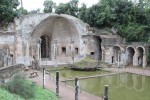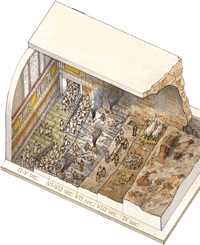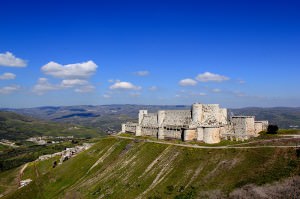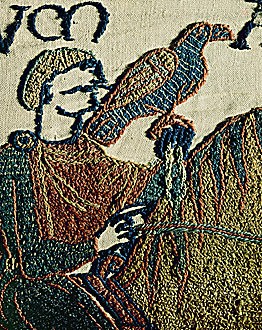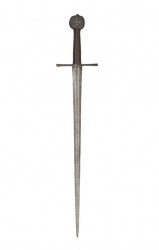The commandment "Make yourself no graven image" has long been strictly followed in the Arab world. There are very few statues of the caliphs and ancient kings of the region. The pagan gods in the desert were usually worshipped in an "aniconic" way, that is, as beings without form.
 ANZEIGE
ANZEIGE
Muhammad had a beard, but there are no portraits of him.
But now a narcissistic work of human self-portrayal has turned up in Yemen. It is a figure, chiseled in stone, which apparently stems from the era of the Prophet.
Paul Yule, an archeologist from the southwestern German city of Heidelberg, has studied the relief, which is 1.70 meters (5'7") tall, in Zafar, some 930 kilometers (581 miles) south of Mecca. It depicts a man with chains of jewelry, curls and spherical eyes. Yule dates the image to the time around 530 AD.
The German archeologist excavated sites in the rocky highlands of
Yemen, an occupation that turned quite dangerous recently because of political circumstances in the country. On his last mission, Yule lost 8 kilograms (18 lbs.) and his equipment was confiscated.
Nevertheless, he is pleased, because he was able to bring notes, bits of debris and bones back to Heidelberg. Yule has concluded that Zafar was the center of an Arab tribal confederation, a realm that was two million square kilometers (about 772,000 square miles) large and exerted its influence all the way to Mecca.
Even more astonishing is his conclusion that kings who invoked the Bible lived in the highland settlement. The "crowned man" depicted on the relief was also a Christian.
Conquerers from Ancient Ethiopia
Yule has analyzed the mysterious, robed figure in a report for the academic journal
Antiquity. He is barefoot, which is typical of Coptic saints. He is holding a bundle of twigs, a symbol of peace, in his left hand. There is a crossbar on his staff, giving it the appearance of a cross. In addition, he is wearing a crown on his head like the ones worn by the Christian rulers of ancient Ethiopia.
All of this suggests that the man with a strange, round face is a descendant of the conquerors from Africa who succeeded in making one of the boldest landing operations in ancient times.
In 525 AD, the Negus, or king, of Aksum dispatched a fleet across the Red Sea. Soldiers and fighting elephants were ferried across the water to the East on un-tarred, raft-like ships to spread the gospel. In the ensuing decades, his army captured large parts of Arabia.
The first spearhead was targeted at the capital Zafar. Like a fortress in the sky, the town was perched on an extinct volcano, at an altitude of 2,800 meters (9,184 feet) above sea level. Its walls, riddled with towers and alarm bells, were four-and-a-half kilometers long. About 25,000 people lived in Zafar.
According to Yule, between the 3
rd and the 5
th century the confederation managed to complete a "meteoric rise" and become a superpower. Its merchants traded in sandalwood from Ceylon and valerian from Persia. The state controlled the port of Aden, where the ships of spice traders from India docked. Frankincense, which was made in Arabia, was also traded. It was a place of luxury. Yule found wine amphorae, the remains of precious fish condiments and palaces decorated with sphinxes and lions.
A Peaceful Multi-Cultural Community
The social structure in Zafar also appeared to be unique. The city had a large Jewish community, as evidenced by a seal with a Torah niche. Hebrew inscriptions were discovered. Zafar's residents also included Christians, who built a church there in 354 AD. Arabs who worshipped old idols lived in the alleys.
But this peaceful, multicultural community soon came to an end, as tensions began to mount in the 5
th century, and Arabia was transformed into a front.
The Byzantine Empire, bristling with weapons, operated in the west, and its vassals kept making inroads toward the desert. They were accompanied by Christian missionaries, who brought the doctrine of the Holy Trinity to the shepherds on the edge of the Rub' al Khali, the sand desert that makes up much of the southern third of the Arabian Peninsula.
These Sacred Heart imperialists confronted the Persian realm of the Sassanids, with its archers and armies of bearded soldiers clad in heavy metal armor. The Jews, who lived by the tens of thousands in the oases, were to some extent aligned with this power.
It was a confrontation between east and west, and everyone was forced to choose a side.
This also applied to Zafar. To stop the advance of Christianity, individual Arab kings initially converted to Judaism. The entire ruling class of the realm eventually followed suit. From then on, people were given names like Yehuda and Yussuf.
Then they took up arms. In approximately 520 AD, they attacked the Christian colony of Najran, where there were churches and monasteries. Countless Christians were slaughtered. The shocking news traveled all the way to Europe.
A 'Puppet King'
Now the spiral of violence began turning more rapidly. The furious Byzantines and their allies from Africa were out for revenge. Kaleb, the Aksumite king of Ethiopia (who wore gold jewelry in his hair and had himself driven around in an elephant carriage) went on the counter-offensive.
If the sources are correct, his first naval maneuver was a miserable failure. In 525 AD, with the help of additional warships provided by the Byzantines, he successfully completed the crossing to the other side of the Red Sea.
The relief of the "crowned man" from Zafar was apparently created during this period of invasion. Yule interprets it as a representation of the Christian "puppet king" of the Ethiopians.
The invaders continued their attacks. Southern Arabia's holy warrior, Abraha, had taken control of large areas before long. He even attempted to free bishops being held prisoner by the Persian enemy in Nisibis (in modern-day Turkey), some 2,500 kilometers away.
The man embarked on a religious crusade at the same time. He rebuilt the churches that had been destroyed in Najran, and he had new ones built in Marib and Aden.
His most beautiful church was in Sanaa. It had gilded doors and a throne made of ebony and ivory. In the morning, the rays of the sun shone through an alabaster panel in the dome. The Byzantines supported the project, sending craftsmen, marble and mosaics.
The result was an architectural miracle, the likes of which all of Arabia had never seen before.
Year of the Elephant
After the triumph of Islam in the 7
th century, the church was torn down and stripped of its treasures, and a mosque was built on the site. As Barbara Finster, an archeologist from the Bavarian city of Bamberg, discovered, some of the columns in the mosque came from the wrecked church, while some of the church's magnificent mosaics were sent to Mecca, essentially as booty.
The enmity between Sanaa and Mecca apparently smoldered from the start. Medieval Koran scholars report that Abraha built his magnificent church to lure the pilgrims away from the Kaaba, Islam's most sacred site.
Another Islamic source describes how the dispute eventually escalated: An angry native of Mecca relieved himself in the Sanaa church, prompting the furious Abraha to dispatch his warriors, mounted on elephants, to destroy the Kaaba. In the interpretation of Sura 105 of the Koran, the only reason he was unsuccessful was that Allah had armed a flock of birds with clay balls that rained down on the Christian army like bullets.
Are these nothing but religious myths? There is historical evidence, in the form of a rock inscription, that Abraha conducted large-scale raids against defiant Arab tribes near Mecca in 552 AD. A few Western historians consider this to be the true year of Muhammad's birth. The scholar Ibn Ishak, who wrote the first biography of the Prophet, states that the proclaimer of the Koran was born "in the year of the elephant."
Oddly enough, the scrawled rock inscription could be interpreted to mean that the tribe of the Kuraish, to which the Prophet belonged, sometimes fought for the Christians. Were they allies? Was Muhammad born in a city that stood under the banner of the cross?
Hard Times
There are indications that this could be true. For instance, a Christian cemetery is mentioned in the oldest history of Mecca, written by the Arab historian Asraki.
What a mess. In ancient Arabia, the three Abrahamic world religions intersected in confusing ways. But the Koran prevailed in the end.
But many things are still unclear. Our perspective is complicated by the fact that the birth of Islam occurred at a time of severe hardship. Climate data obtained from limestone caves in Oman prove that there was a terrible drought in the southern part of the Arabian Peninsula in the middle of the 6
th century. There was also a plague epidemic that began in 541 and afflicted the entire Orient. Other, smaller epidemics followed, causing thousands upon thousands of deaths.
It was these horrors that probably triggered the demise of Zafar. Yule suspects that the drought devastated the "fragile ecology of the highlands." Cattle died of thirst and barns remained empty.
Are the archeologist's suspicions correct? Even Muhammad, as a young child, was threatened by disease and hunger. According to Ibn Ishak, his wet nurse was deeply concerned when she was told to bring the little boy back to his native city.
The reason, he writes, was the "plague in Mecca."







